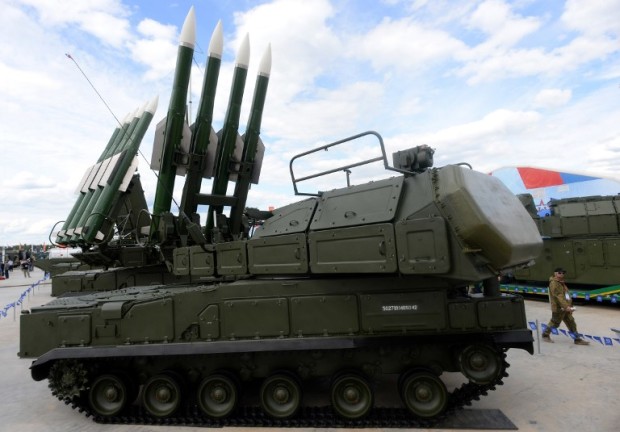BUK: Russia’s feared anti-aircraft missile system

A visitor walks past a Russian self-propelled surface-to-air missile systems BUK-M2E during the ‘Army-2015’ international military forum in Kubinka, outside Moscow, on June 17, 2015. A Dutch-led inquiry said a BUK missile shot down Malaysia Airlines MH17 in 2014. AFP PHOTO
MOSCOW, Russia — The BUK missile system blamed for shooting down flight MH17 over east Ukraine, killing all 298 people on board, is an anti-aircraft weapon whose origins date back to the Soviet era.
The system is designed to be a mobile surface-to-air system able to engage multiple targets at a variety of ranges.
BUK — which means “Beech” in Russian — first fully entered service with the Red Army in 1980, and has been exported to many countries, including North Korea and Syria. NATO’s official designation for it is the SA-11 Gadfly.
READ: Probe: Malaysian jet downed by missile launcher from Russia
The system fires a single-stage 700-kilogram (1,500-pound) missile whose warhead explodes in close proximity to the target, shredding it with high-velocity shrapnel.
Article continues after this advertisementUp to six BUK missiles can be fired simultaneously from a launch vehicle — usually either a military truck or a tank — on targets flying on different bearings, according to the London-based Jane’s defense and intelligence group.
Article continues after this advertisementThe missiles lock onto targets using a separate radar system that is usually operated from an accompanying mobile unit.
It works by exploding close to a target and sending a hailstorm of shrapnel across a wider area.
The system can operate in any weather and reportedly hit some targets at an altitude of 25 kilometers (15 miles) or more.
Findings from the Dutch-led criminal inquiry released Wednesday said the Malaysia Airlines Boeing-777 “was shot down by a BUK missile from the 9M38-series.”
The aircraft was flying at a cruising altitude of 33,000 feet (about 10 kilometers).
The international probe said that “the system was transported from Russian territory into eastern Ukraine” and fired from a field in rebel-held territory.
The findings appear to back up long-standing accusations from Ukraine and the West that the pro-Russian rebels downed MH17 with a missile likely provided by Moscow.
Russia and the separatists furiously deny this and have instead pointed the finger of blame at Kiev’s forces.
Russian state-controlled manufacturer of the BUK system Almaz-Antey has previously claimed that if the plane was downed by a missile then it had to be the 9M38 model.
This older variant of the missile was produced until 1986 and went out of service in Russia in 2011, but is still likely in Ukraine’s stockpiles.
The company had earlier claimed that the missile could only have been the more modern 9M38M1 version that was discontinued in 1999. CBB